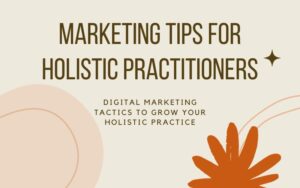In the world of health and wellness, standing out is key. This is where SEO comes in. It’s not just helpful—it’s crucial to use proven SEO strategies in order to grow organic traffic.
By using these strategies, including selecting the right keywords, specifically related to alternative medicine and holistic health, wellness businesses can boost their online presence, attract the right audience, and stay ahead of the game.
Furthermore, holistic SEO isn’t just about ranking higher on search engines; it’s about connecting with people seeking health and wellness advice. That connection can lead to more patients, sales, and leads.
So how do you select the right keyword to use when it comes to your health website content. The following strategies will help you in your quest to boost your organic traffic.
Understanding Your Audience and Keywords
To effectively optimize your wellness site, understanding your audience and the specific keywords they use is crucial. Here’s how you can align your SEO strategies with audience needs:
Conduct Thorough Keyword Research
Start by identifying search terms that your target audience frequently uses. Tools like SparkToro are invaluable for this purpose. Understanding these keywords helps in tailoring your content to meet the audience’s specific inquiries.
Analyze Search Intent
It’s not just about the keywords; it’s also vital to understand the intent behind these searches. Are your potential clients looking for information, a product, or a service? This insight will guide your content creation. Do a search and see what type of answers Google provides. If most of the results show shopping links, you might want to create content that is similar to the top answers.
Focus on Long-Tail Keywords
While broad keywords are competitive, long-tail keywords (specific and often query-based) can significantly improve your site’s visibility and relevance. These keywords account for 70% of all web searches and are less competitive, making them ideal for a niche market like wellness.
Utilize Local SEO Practices
Incorporate location-based keywords to attract local traffic. Terms like “yoga classes in [City Name]” or “nutritionists near me” can help capture an audience that’s looking for local wellness options.
Use SEO Tools for Competitive Analysis
Understanding what keywords competitors in the wellness niche are targeting can provide insights into market trends and help refine your keyword strategy. There are many popular tools you can use like SEMRush and ahrefs. These are fairly expensive and there are many less pricy alternatives like SERanking and Ubersuggest
Answer Customer Questions and Search Queries
Listen to the questions your customers are asking and integrate these into your content. This not only improves SEO but also enhances user engagement by providing valuable answers to their concerns.
Health Websites Keyword Placement Best Practices
Optimize HTML Tags with Main Keywords
To enhance your wellness site’s SEO, start by optimizing HTML tags. Insert main keywords into title tags and heading tags. This strategy helps search engines understand and index the content of your pages effectively.
Create and Interlink Landing Pages
Develop landing pages that serve as focal points for visitors, then interlink these with other relevant content on your site. This not only boosts SEO but also improves navigation and user experience.
Utilize Schema Markup
Incorporate schema markup to provide search engines with more context. Include details such as medical specialties, procedures, accepted insurance plans, and contact information. This additional layer of information can significantly enhance your visibility in search results.
Regular Content Updates
Keep your website fresh by regularly updating it with new articles and blog posts. This signals to search engines that your site is active and offers up-to-date, valuable information to potential clients. Furthermore every article you write, has a potential to grow your traffic over time by increasing the number keywords your website is ranking.
Leverage Long-Tail and Related Keywords
Incorporate long-tail keywords naturally in product titles, descriptions, and blog posts. These keywords are less competitive and more specific, which can attract a more targeted audience.
Also, target related keywords to cover broader topics relevant to your audience.
Align Content with Search Intent
Ensure that your content aligns with the search intent of your audience. Use keywords that match the user’s search queries to improve content relevance and engagement.
Comprehensive On-Page Optimization
Focus on writing compelling title tags and meta descriptions, optimizing images, and improving page loading speed. These elements are crucial for enhancing your site’s SEO and user experience.
Build a Strong Internal Linking Structure
Develop a robust internal linking strategy. Link high-trafficked pages to relevant, less-trafficked pages to boost their visibility and SEO. This also enhances the overall user experience by providing easy access to related content.
Earn Authoritative Backlinks
Focus on earning backlinks from reputable and authoritative sites. These backlinks can significantly boost your site’s credibility and search rankings.
By implementing these best practices, you can effectively enhance your wellness site’s SEO, making it more visible and accessible to potential clients.
Quality Content Over Quantity
Emphasizing Quality in Content Creation
High-quality content is essential for engaging your audience effectively and enhancing your site’s SEO performance. Here are several key practices to ensure your content meets high standards:
Value-Driven Content: Focus on creating content that provides real value to your audience, enhancing user experience and engagement.
SEO Optimization: Search engines prioritize content that is relevant, useful, and well-written, which increases your chances of ranking higher in search results.
Backlink Attraction: Quality content naturally attracts more backlinks from reputable sites, which can significantly boost your SEO efforts.
Keyword Integration: Employ natural and effective keyword optimization within your content to maintain readability and search engine relevance.
Enhanced Social Engagement: High-quality content tends to generate more social media shares and interactions, expanding your reach and audience engagement.
Consistency in Publishing: Regularly updating your site with high-quality content keeps your brand top-of-mind and builds trust with your audience.
Editorial Standards: Maintain a high standard for content quality, whether it’s produced in-house or outsourced, to ensure consistency across your publications.
Complex Concepts Simplified: Aim to present complex information in an easy-to-understand format while adhering to general grammar and style rules.
Strategic Content Planning: Use an editorial calendar to plan the types and frequency of content, ensuring a balanced approach that does not sacrifice quality for quantity.
By prioritizing these elements, you not only enhance the user experience but also improve your site’s performance in search engine rankings, leading to better visibility and more effective audience engagement.
Using Long-Tail Keywords to Capture Niche Markets
Long-tail keywords are essential for targeting specific niche markets within the health and wellness industry. These keywords, which are typically longer and more specific than general search terms, can significantly enhance your site’s visibility and attract a more targeted audience.
1. Understanding Long-Tail Keywords
Long-tail keywords are not just about being longer; they are often closer to natural language queries and represent a clearer intent from the user. This specificity leads to higher conversion rates as the traffic driven by these keywords is more likely to be looking for exactly what you offer.
2. The Impact of Google’s Medic Update
Health-related websites, categorized under Google’s “Your Money, Your Life” (YMYL) standards, face stringent scrutiny. The Medic update in 2018 particularly affected these sites, emphasizing the need for high E-A-T (Expertise, Authority, Trustworthiness). Long-tail keywords can help demonstrate your site’s authority and relevance in specific health and wellness niches.
3. Building E-A-T with Long-Tail Keywords
To boost your website’s E-A-T, integrate long-tail keywords that align with your expertise. Use detailed author bylines and robust ‘about’ pages to highlight qualifications and experience, reinforcing your site’s trustworthiness. Additionally, incorporating verified customer reviews and detailed company information can further build trust.
4. Strategic Implementation of Long-Tail Keywords
Start by identifying long-tail keywords using tools like the Keyword Magic Tool, which can generate thousands of relevant keywords quickly. Also, perform a keyword gap analysis to discover valuable long-tail keywords that your competitors might be ranking for but you are not.
5. Creating Content Around Long-Tail Keywords
Develop content that specifically addresses the queries related to your chosen long-tail keywords. This involves creating topic clusters—linking from pages targeting long-tail keywords to those targeting broader head terms, thus enhancing the topical authority of your website.
By strategically using long-tail keywords, you can effectively capture niche markets, improving both the quantity and quality of traffic to your wellness site, ultimately leading to increased engagement and conversions.
Analyze and Adjust Your Keyword Strategy
To ensure your wellness site remains competitive and responsive to market changes, regularly analyzing and adjusting your keyword strategy is critical. This iterative process involves several key steps:
Monitor SEO Performance
Regularly check your SEO performance using tools like Google Analytics. This allows you to see which keywords are driving traffic and which ones may need reevaluation.
Review Website Analytics
Dive into your website analytics frequently to understand how visitors interact with your site and which content performs best. This data is crucial for refining your keyword strategy over time..
Assess Keyword Rankings
Regularly reviewing your keyword rankings can provide valuable insights. Use Google Search Console to examine the “Queries” table, which shows the keywords your site ranks for over a selected time range.
Identify Keyword Opportunities
Discover new keyword opportunities by identifying relevant search terms that you have not yet capitalized on. By looking at other sites and figuring out what keywords they’re ranking, you can create a strategy to include these keywords into your own website.
Evaluate Search Volume and Competition
Before deciding on a keyword, assess its search volume and competition. Pay attention to metrics that show how difficult it would be to rank specific keyword or phrase. In a similar manner make sure you can actually rank for individual keyword. The best keywords are least competitive and have the most amount of traffic, so you might need to spend time finding keywords that fulfill both of these conditions at the same time.
Use Strategic SEO Tools
Employ SEO tools to refine your approach to finding long-tail keywords. Tools like Google’s autocomplete, ‘People Also Ask’, and Related Searches provide insights into what your audience is searching for.
Track Long-Tail Keyword Performance
Keep a close eye on how your long-tail keywords perform. Adjust your strategy based on this performance to better meet your business goals.
Perform Competitor Analysis
Understanding what keywords your competitors are targeting can offer a strategic advantage. Analyze this to adjust your keyword strategy accordingly.
By following these steps, you can ensure that your keyword strategy remains robust and responsive, helping to drive targeted traffic to your wellness site. This ongoing process of analysis and adjustment is crucial for staying ahead in the competitive SEO landscape.
Holistic Websites Keyword & SEO FAQs
1. How can I effectively optimize my SEO keywords to enhance my website’s performance?
To optimize your SEO keywords effectively, consider grouping similar keywords to strengthen your content’s relevance. Map your keywords to specific pages to ensure they align with the content and user intent. Focus on creating high-quality content that matches the search intent of your audience. Additionally, write compelling title tags and meta descriptions, use and optimize HTML headings, create user-friendly URLs, and optimize your images to improve overall SEO performance.
2. What strategies can I use to enhance brand visibility through SEO?
Enhancing brand visibility through SEO involves several strategic steps. Start with keyword optimization to ensure your brand is associated with what you offer. Generate fresh and engaging content regularly and ensure your website is mobile-friendly to cater to a broader audience. Optimize on-page elements like meta tags and images, focus on local SEO for geographically-targeted visibility, and build quality backlinks to increase your site’s authority and visibility.
3. What are effective methods to integrate keywords into my website?
To integrate keywords effectively into your website, start by adding them to critical SEO elements such as meta descriptions, meta title tags, and page URLs. Incorporate keywords into the titles, headers, and alt tags for images. Place keywords strategically in the first and last paragraphs and distribute them evenly throughout your content. Always ensure that the use of keywords feels natural; if it doesn’t fit smoothly, it’s better not to use it.
4. What are some effective ways to incorporate SEO into my content strategy?
Incorporating SEO into your content strategy can be achieved through several effective methods. Utilize keyword research to plan your content and align it with what your audience is searching for. Adopt a hub-and-spoke model to create interconnected content that boosts SEO. Apply the inverted pyramid technique to structure your content effectively. Keep your content fresh by updating it regularly, leverage expertise by involving subject matter experts, promote positive reviews about your company, and drive direct traffic to your website to enhance SEO outcomes.
Conclusion
Integrating SEO keywords into health and wellness content strategy is essential for driving organic traffic and reaching the target audience. By conducting thorough keyword research, understanding user intent, and strategically incorporating keywords into high-quality, informative content, health and wellness websites can improve their search engine rankings and visibility. Furthermore, focusing on user experience and providing valuable, trustworthy information will not only enhance SEO performance but also build credibility and trust with the audience. Embracing a holistic approach that combines SEO best practices with compelling, relevant content will ultimately contribute to the success of health and wellness websites in the digital landscape.





